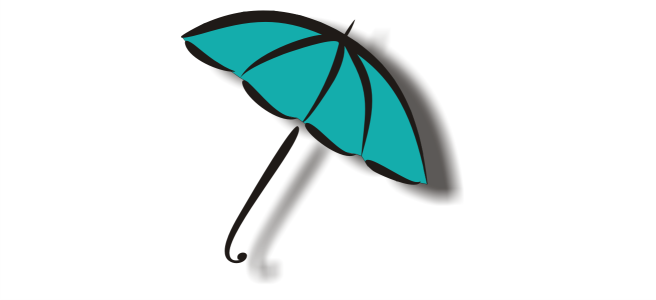Quick links to procedures on this page:
Drop shadows simulate light falling on an object from one of five particular perspectives: flat, right, left, bottom, and top. You can add drop shadows to most objects or groups of objects, including artistic text, paragraph text, and bitmaps. You can also use extrusions to create shadows.
Drop shadows and extrusions created in CorelDRAW are ideal for printed outputs, but are not appropriate for output to devices such as vinyl cutters and plotters. Cuttable shadows are needed for such projects. To add a cuttable shadow to an object, you must use a block shadow. For more information about block shadows, see Adding block shadows. You can also create a cuttable shadow by duplicating the object, filling the duplicate with a dark color, and then placing it behind the original object.
When you add a drop shadow, you can change its perspective, and you can adjust attributes such as color, opacity, fade level, angle, and feathering.
A drop shadow applied to an object
The feathered effect softens the edges of a drop shadow.
Drop shadows look more realistic when they use Gaussian Blur feathering, which is the default option. You can change the feathering of drop shadows from the Feathering direction button on the property bar.
Feathering options for drop shadows
After you create a drop shadow, you can copy it or clone it to a selected object. When you copy a drop shadow, the original and copy have no connection and can be edited independently. With cloning, the master object’s drop shadow attributes are automatically applied to its clone.
By separating a drop shadow from its object, you gain more control over the drop shadow itself. For example, you can edit the drop shadow as you would edit a transparency. For information about editing a transparency, see Changing the transparency of objects.
As with transparencies, you can apply a merge mode to a drop shadow to control how the color of the drop shadow blends with the color of the object underneath. For more information about merge modes, see Applying merge modes.
You can remove a drop shadow.

Drop shadows cannot be added to linked groups, such as blended objects, contoured objects, beveled objects, extruded objects, objects created with the Artistic media tool  , or other drop shadows.
, or other drop shadows.
| 2 . |
Click Edit  Duplicate. Duplicate. |
| 4 . |
Click Object  Order Order  Behind, and click the original to position the duplicate behind it. Behind, and click the original to position the duplicate behind it. |

You can also create a cuttable shadow by using the Block Shadow tool  . For more information, see To add a block shadow.
. For more information, see To add a block shadow.
| 2 . |
Click Effects and click one of the following: |

You can also use the Attributes eyedropper tool  to copy a drop shadow. For more information, see To copy effects from one object to another.
to copy a drop shadow. For more information, see To copy effects from one object to another.
| 2 . |
Click Object  Break drop shadow group apart. Break drop shadow group apart. |

The default merge mode Multiply produces natural-looking drop shadows.
| 2 . |
Click Effects  Clear drop shadow. Clear drop shadow. |

You can also remove a drop shadow from an object by clicking the Clear drop shadow button  on the property bar.
on the property bar.

Not all suite components documented in this Help are available in our Trial, Academic, and OEM versions. Unavailable components may include Corel applications, product features, third-party utilities, and extra content files.
Copyright 2018 Corel Corporation. All rights reserved.

, or other drop shadows.
. For more information, see To add a block shadow.
to copy a drop shadow. For more information, see To copy effects from one object to another.
on the property bar.
![]()